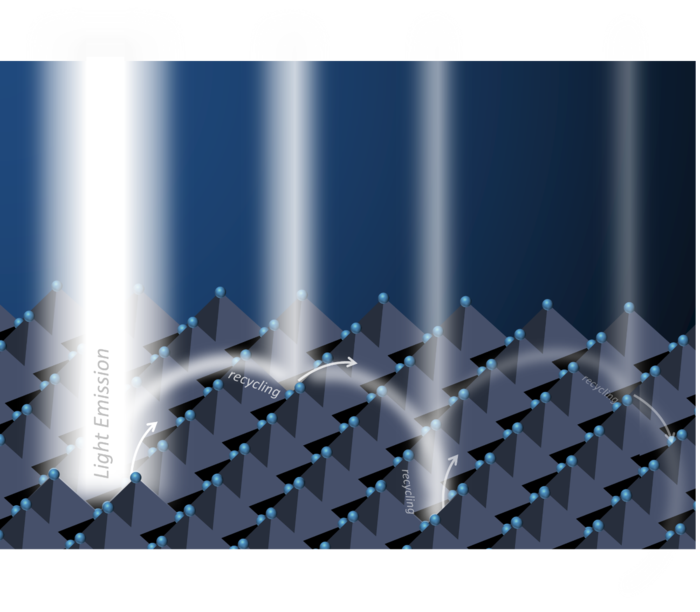For metal halide perovskites to challenge well-established silicon-based photovoltaics, the former would need to approach the upper limit of photovoltaic efficiency, aka the Shockley–Queisser (SQ) limit, which is only possible if the solar cell is both a good light absorber and emitter. With the latest perovskite solar cells having achieved near-unity light absorption and efficient charge collection under short-circuit conditions, enhancing electroluminescence quantum efficiency is believed to be the final key to reducing voltage loss and reaching the SQ limit.
With that in mind, researchers from the Dresden Integrated Center for Applied Physics and Photonic Materials (IAPP), at the Technische Universität Dresden, have examined the effect of photon recycling and found significant additional light emission is achieved by recursively recycling trapped photons in perovskites.
When a photon is radiated inside re-absorbing semiconductors such as perovskites, it can be re-absorbed by the emitter itself and a new photon can be generated via photoluminescence. Such a process of recursively re-absorbing and re-emitting the photons is called photon recycling. The IAPP researchers say photon recycling and light scattering effects greatly improve light emission efficiency by a factor of around five, thus significantly improving the photovoltage of perovskite solar cells.
“Perovskites are already good absorbers,” said Changsoon Cho, who led the work as a Humboldt research fellow at IAPP. “Now it’s time to improve their light-emitting ability to even further increase their already high power conversion efficiencies. Understanding photon recycling is a crucial step towards this direction.”
The researchers also found that, via photon recycling, the upper limit for the efficiency of the perovskite solar cells rose from 29.2% to 31.3%. Their work predicts that the contribution of photon recycling, along with the suppression of various optoelectrical losses, will lead to a further increase in performance in the future.
The research results were recently published in the paper “Effects of Photon Recycling and Scattering in High-Performance Perovskite Solar Cells,” in the journal Science Advances.
This content is protected by copyright and may not be reused. If you want to cooperate with us and would like to reuse some of our content, please contact: editors@pv-magazine.com.




3 comments
By submitting this form you agree to pv magazine using your data for the purposes of publishing your comment.
Your personal data will only be disclosed or otherwise transmitted to third parties for the purposes of spam filtering or if this is necessary for technical maintenance of the website. Any other transfer to third parties will not take place unless this is justified on the basis of applicable data protection regulations or if pv magazine is legally obliged to do so.
You may revoke this consent at any time with effect for the future, in which case your personal data will be deleted immediately. Otherwise, your data will be deleted if pv magazine has processed your request or the purpose of data storage is fulfilled.
Further information on data privacy can be found in our Data Protection Policy.